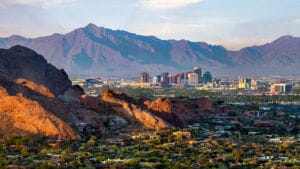Forests of Saguaro cacti lit by fiery red and orange sunsets, gun-toting cowboys staging shoot-outs, and the Grand Canyon’s striated walls looming over the Colorado River.
One would think these distinctly Arizona images could sell themselves. Unfortunately, Arizona’s tourism industry is learning the hard way that it takes more than just the state’s natural beauty and attractions to bring in visitors — it takes dollars.
“That’s why we need to be out there marketing Arizona, reminding people about what a great, wonderful, warm, welcoming destination we are,” says Debbie Johnson, executive director of the Arizona Tourism Alliance and president and CEO of the Arizona Hotel & Lodging Association.
The recession caused Arizona’s once vibrant tourism industry to flounder, and in 2009, the stigma related to the corporate meetings industry continued the industry’s downward spiral.
“We weren’t just feeling the pain like everybody else. We were getting hit much more significantly than the nation overall,” says Mitch Nichols, president of Nichols Tourism Group, which provides research services to the tourism industry.
Visitor spending in Arizona decreased 10.6 percent, while the nation saw a decrease of just 4.4 percent, from 2007 to 2009. Additionally, Arizona lost $780 million in potential visitor spending because its share of national travel expenditures dropped from 2005 to 2008, according to Nichols Tourism Group.
In early 2010, the state Legislature dealt the industry a one-two punch when it passed SB 1070 and redirected funds from the Arizona Office of Tourism’s (AOT) budget to the general fund.
The Legislature redirected the tourism formula fund, which is composed of 3.5 percent of the state’s bed tax, 3 percent of the state’s amusement tax, and 2 percent of the state’s restaurant tax. This redirection will take approximately $28 million away from AOT over the 2011 and 2012 fiscal years.
In November 2010, the Center for American Progress, a progressive think tank, announced more bad news for Arizona’s tourism industry. In a study, it was reported that the controversial SB 1070 bill had cost the state $141.4 million in lost spending.
However, the industry isn’t down for the count.
Led by the Arizona Tourism Alliance, the tourism industry is campaigning to reclaim the budget, which it believes will help pull Arizona out of the recession and return millions of visitors to Arizona.

While the long-term effects of SB 1070 on the tourism industry are hard to quantify, the budget redirection is projected to cost Arizona big.
Even the most conservative estimate puts the state’s losses at $26.7 million, but “actual revenue losses could potentially be many times this amount,” according to an independent study by Elliot D. Pollack & Co.
Nichols Tourism Group estimates the state could lose as much as $1.6 billion.
“You’re not finding $14 million. You’re creating a much bigger hole that will have to be funded in the future,” Nichols says.
The redirection of money decimated AOT’s marketing budget, allowing other states to sneak in and steal Arizona’s market share. These states recently discovered the tourism industry’s power to pull a state out of the recession.
“Some of our key competitors, California in particular, got much more aggressive in terms of the resources they were spending to try and convince visitors to choose California,” Nichols says.
Arizona is becoming out of sight, out of mind, and statistics prove it, Johnson adds.
From January to August 2010, the daily rate for Arizona hotel rooms declined 4.4 percent, while the nation’s daily rate only declined by 1 percent, and California’s daily rate declined by 1.1 percent, according to Nichols Tourism Group.
“Too often there’s a mindset that people will come whether or not you advertise. And we’ve got to increasingly ensure that kind of mindset does not carry the day,” Nichols says.
To remedy the industry’s declining revenue, Arizona’s Legislature needs to be reminded of what tourism means to the state. Tourism brings in revenue that funds education and many of the public services that are necessary during recessionary times.
The return on investment for every dollar spent on tourism marketing is seven to one, out-of-state studies show, according to the Pollack study.
In addition to pulling in revenue, the tourism industry directly and indirectly employs around 300,000 Arizonans, about 10 percent of the state’s work force.
Two key pieces of Arizona’s future, the economy and the work force, depend upon tourism. If the budget is restored, and soon, Arizona can rebound to pre-recession numbers within five years, Johnson says.
“Our destination has shown … that we can come back from adversity,” Johnson says. “We saw that after 9/11. (We were) one of the top five destinations, in terms of rebounding. I think we’re going to see that again because of what we have to offer, because we do have such a strong industry here. We’re a united industry. We work together and we come together in times like this. I think you’re going to see Arizona rebound.”




